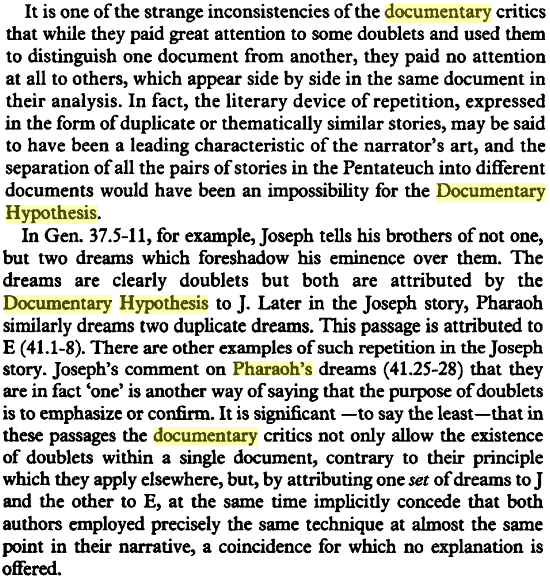An interesting thought occurred to me while reading over Ibn Caspi on Miketz, and, baruch shekivanti, I see that others have raised something similar before me.
Pharoah's dreams are related twice -- once by the narrator and once in Pharaoh's retelling. (And a third time, within Yosef's interpretation.) This is thus a "doublet". And there are slight "inconsistencies" between the two, in terms of descriptions, and details in one and not in the other. Does the Documentary Hypothesis divide these into different documents? And if not, why not? Why do they make a big deal of some doublets and not others, and why some inconsistencies (which are, upon close examination, making a mountain out of a molehill) and not others?
To cite Ibn Caspi about the inconsistencies:
"And Pharaoh said to Yosef, in my dream...: I have already written in the sefer Tiras Kesef the reason of the repetition and the change in words which appear."
Here is what Ibn Caspi says on that page (124) of Tiras Kesef:
The changes in the dream are minor, and might simply be natural variation, or else the true elaboration that emerges as one naturally tells over a dream. But a midrash picks up on these changes, and that Yosef changed them back in the interpretation, to proffer that Pharaoh deliberately changed the dream as a test, and Yosef passed the test by telling Pharaoh his true dreams.
Examples of the sorts of variations one might spot:
Yet, all these are assigned to E.
I looked into it a bit (meaning a few minutes of Googling), and I saw that a similar (but not precisely identical point) was made by Whybray in The Making of the Pentateuch: A Methodological Study, pg 78:
Thus, the doublets he points out are the fact that Yosef has two dreams with the same message; Pharaoh has two dreams with the same message. (Similarly, I would point out, the butler and baker have similar dreams with slight contrasts which lead to opposite messages.) And these are assigned to the same author, J and E, respectively, and it is understood that parallelism from doublets are used by both authors as a technique.
a
Pharoah's dreams are related twice -- once by the narrator and once in Pharaoh's retelling. (And a third time, within Yosef's interpretation.) This is thus a "doublet". And there are slight "inconsistencies" between the two, in terms of descriptions, and details in one and not in the other. Does the Documentary Hypothesis divide these into different documents? And if not, why not? Why do they make a big deal of some doublets and not others, and why some inconsistencies (which are, upon close examination, making a mountain out of a molehill) and not others?
To cite Ibn Caspi about the inconsistencies:
"And Pharaoh said to Yosef, in my dream...: I have already written in the sefer Tiras Kesef the reason of the repetition and the change in words which appear."
Here is what Ibn Caspi says on that page (124) of Tiras Kesef:
The changes in the dream are minor, and might simply be natural variation, or else the true elaboration that emerges as one naturally tells over a dream. But a midrash picks up on these changes, and that Yosef changed them back in the interpretation, to proffer that Pharaoh deliberately changed the dream as a test, and Yosef passed the test by telling Pharaoh his true dreams.
Examples of the sorts of variations one might spot:
When Pharaoh repeated his dream to Joseph, he changed it a bit, either purposely to see if Joseph really knew, or unintentionally, as we often don't remember exact details. For example, Pharaoh started off on the shore of the river (taking a sun tan!) while the original dream said "On the river," stressing the Nile as the sustenance of Egypt. Pharaoh stressed the aesthetic aspect of the cows: "I never saw such poor cows in all of Egypt" (Genesis 41:19), instead of the fact that they were skinny and fat.Or, as voiced by Tanchuma Miketz, siman 3:
ויוסף ענו בכבל רגלו ברזל באה נפשו (תהלים קה)These are, perhaps, weak sorts of variations. (But then, I consider Yishmaelim / Medanim / Medanim as the ones who bought Yosef from the brothers to also be a somewhat weak variation.)
ונתרומם, שנאמר: ויוסף הוא השליט על הארץ.
אמר ליה פרעה: חלום חלמתי. אמר יוסף: בלעדי אלהים יענה וגו', תלה הגדולה בבעליה.
אמר הקב"ה: אתה לא רצית להתגדל בעצמך, חייך, שעל ידי כך תעלה לגדולה ולמלוכה.
אמר פרעה: חלום חלמתי, כשבא לומר לו את החלום בקש לבודקו, והיה מהפך לו את החלום. אמר ליה: והנה מן היאור עולות שבע פרות.
אמר ליה יוסף: לא כך ראית, אלא יפות מראה ובריאות בשר.
אמר ליה: הנה שבע פרות דלות ורעות.
א"ל: לא כך ראית, אלא רעות מראה ודקות בשר.
א"ל: הנה שבע שבלים מלאות וטובות.
א"ל: לא כך ראית, אלא בריאות וטובות.
א"ל: והנה שבע שבלים צנומות דקות.
א"ל: לא כך ראית, אלא דקות שדופות קדים.
התחיל פרעה תמה בעצמו.
א"ל: אחרי היית כשחלמתי, שנאמר: אחרי הודיע אלהים אותך את כל זאת, הוא שאביו מברכו: בן פורת יוסף (בראשית מט), אל תקרא בן פורת אלא בן הפרות יוסף.
השיב פרעה: אתה תהיה על ביתי.
Yet, all these are assigned to E.
I looked into it a bit (meaning a few minutes of Googling), and I saw that a similar (but not precisely identical point) was made by Whybray in The Making of the Pentateuch: A Methodological Study, pg 78:
Thus, the doublets he points out are the fact that Yosef has two dreams with the same message; Pharaoh has two dreams with the same message. (Similarly, I would point out, the butler and baker have similar dreams with slight contrasts which lead to opposite messages.) And these are assigned to the same author, J and E, respectively, and it is understood that parallelism from doublets are used by both authors as a technique.
a




No comments:
Post a Comment